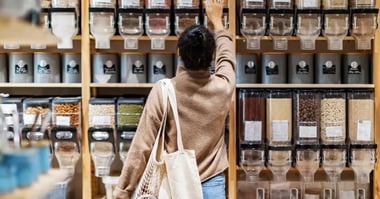
Tamara Davison
Tamara Davison is a journalist who specializes in sustainability and the environment. Reporting from around the world, she's seen firsthand the direct impact waste is having on coastal communities and our oceans. As a diver trained in ecological monitoring, the changes Tamara has seen in marine habitats inspired her to action. She's previously written for The Guardian, The Independent and the Evening Standard. She's also produced environmental documentaries for EuroNews.
According to a 2024 study, just 56 companies are responsible for producing half of the world’s plastic pollution.
The research included several food and beverage brands, tobacco conglomerates, and cosmetic giants. Regardless of the market, the retail industry plays a massive role in our planet’s plastic crisis.
From unnecessary product and packaging waste, to manufacturing and shipping emissions, the planet is paying the price for retail trends that focus on growth, profit, and sales — but it doesn’t need to be this way.
Designed to reduce environmental harm and create a balanced approach to shopping, more and more retailers are recognizing the financial benefits of focusing on sustainability and a greener future. Here’s what you need to know.
What’s on this page?
01 | What is sustainable retail?
02 | The importance of sustainability in retail
03 | How sustainability is transforming the retail space
04 | What sustainable retail means for brands
05 | How to become a sustainable retailer
05 | Summary
What is sustainable retail?
Sustainable retail is a pretty broad term, but it essentially involves selling products with a lower environmental impact.
This includes selling products that focus on reducing emissions and using packaging materials that don’t contribute to plastic pollution.
Generally speaking, sustainable retail brands value environmental, social, and governance (ESG) principles and strive to maximize profits without compromising eco-friendly values.
Unlike standard retailers, which focus predominantly on short-term gains, sustainable retail involves adopting a holistic approach where sustainability underlines all business operations.
The importance of sustainability in retail
A growing number of studies are finding correlations between eco-friendly products and customer appetite, with more than four-fifths of shoppers willing to pay more for sustainabile products.
In short, a lot of customers care about the planet and want to support retailers that take action. Unsurprisingly, brands are also paying attention — at least 80% of retailers agreed that focusing on sustainability enhances consumer loyalty.
A further 59% of executives from 22 countries around the world said their brands had incorporated some environmentally friendly materials into their offerings.
Companies that embed sustainability into their brand values have even noticed some improvement in their ability to get products on shelves.
Daniel Cray, founder of Phizz, told CleanHub that retailers like Sainsbury’s have a ‘future brands’ program to find disruptive small businesses with unique sustainability approaches and help them secure shelf space.
“They know there’s a customer that’s looking for that,” he said. “While it could easily be looked over because of bigger budgets coming from multi-nationals, they want to champion that.”
Sustainability will continue to shape shopping trends in years to come, and it's never been a better time to embrace retail practices that put the planet first.

How sustainability is transforming the retail space
According to Deloitte, 73% of chief experience officers operating in the consumer industry have increased investments in sustainability over the last few years.
This is mainly fuelled by pressure from conscious consumers, stakeholders, board members, and regulators, who are shaping the direction of the retail industry.
But what exactly are the trends in sustainable retail? From technology to circular economy practices, here are some examples:
- Waste reduction initiatives: Over 75% of consumers surveyed in early 2024 said they’d back a ban on single-use plastic packaging. As a result, many retail brands are rethinking their relationship with packaging to reduce waste. In the beauty and cosmetics sector, that’s emerged through refillable containers and biodegradable packaging, whereas the food industry is focused on compostable packaging and bulk buying solutions.
- Sustainability reporting: Encouraged by increased regulation, brands are investing more in reporting tools that help them track their environmental impact. Businesses can share data about reduced carbon emissions and plastic collection initiatives online and help spread awareness about sustainable missions. At CleanHub, for example, we use track-and-trace technology, allowing clients to share plastic waste collection statistics with their audience in real time, enhancing transparency and accountability and showcasing action.
- Material innovation: From packaging to products themselves, there have been a lot of promising developments in material innovation. In fashion, for example, brands have developed new materials like ECONYL, a fabric made from recycled nylon. Trends in sustainable materials are also taking place in other industries, with brands increasingly focusing on the environmental credentials and end-of-life handling of products.
- Circular economy models: According to the National Retail Federation, “the future of retail is circular.” A lot of retailers are starting to talk about the importance of a circular economy, where products and materials can remain in circulation for longer to reduce waste and support the planet. This comes in the form of buyback and re-sale strategies or recycling initiatives.
What sustainable retail means for brands
Sustainable retail ultimately hinges on embracing forward-thinking transformations in the retail space, which puts the environment front and center. Here is how your brand could benefit:
Brand reputation and consumer trust
A large portion of consumers are willing to pay more for sustainable products. Some studies suggest that around 70% of consumers would pay up to 10% more for eco-friendly purchases.
At least two-thirds of shoppers agree that sustainable packaging is also somewhat important to them, so there’s a lot of incentive to switch from single-use plastic to environmentally friendly alternatives.
Communicating your sustainable commitment through packaging and marketing can attract conscious consumers, build trust, and enhance your reputation as an environmentally friendly brand. In short, it can give you a competitive market edge at a time when customers and supermarkets are looking to back smaller, sustainable brands.
On top of that, roughly 80% of investors said they’re paying increased attention to ESG and plan to up their sustainable investments in the next five years. So, not only can sustainable retail unlock new client bases, but it can also help you secure the support of new investors.
Cost implications and long-term savings
There’s a big misconception that incorporating sustainable practices can be costly regarding materials and the time it takes to overhaul operations. And although there will be some costs involved in the initial steps, this transition can help future-proof your business while driving down long-term expenditures.
For example, using recycled materials decreases a company’s reliance on raw sources and can sometimes cut down costs associated with extraction and manufacturing. In addition, the emergence of government incentives and tax breaks for businesses investing in sustainable practices may offer a financial boost.
Focusing on sustainable retail can also encourage business growth. An NYU report revealed that products advertised as sustainable grew almost 2.7x faster than those that weren’t, so sustainability can also enhance profit margins.
Regulatory compliance
A lot of countries are starting to implement regulations geared toward supporting the environment. This includes the UK’s Plastic Packaging Tax, which charges brands that use plastic packaging that contains less than 30% recycled plastic. In the European Union, similar packaging regulations have also recently been passed.
While laws are a little more fragmented in the United States, some states have also introduced environmental bills, such as New York’s Packaging Reduction and Recycling Infrastructure Act.
Given the current situation, more regulation will likely emerge in the next few years. To minimize the impact regulation may have on retail products, it’s best to start thinking about sustainable strategies sooner rather than later.

How to become a sustainable retailer
Retailers can adopt several strategies to improve their sustainability agenda. Some approaches may be more beneficial than others, depending on the sector they operate in and the products they sell.
Support a plastic credit program
Unlike carbon credits, plastic credits enable retailers to fund plastic waste collections worldwide and ensure proper recycling.
Plus, product purchases can fund plastic credits so your customers can help the planet while supporting your brand.
CleanHub has collected over 9,529,204kg of plastic waste while supporting coastal communities with work and training opportunities. This has all been financed by our brand partners, who, through their contribution, are supporting coastal communities around the world.
Invest in sustainable packaging
Transitioning from single-use plastic to eco-friendly packaging alternatives is a great way to show off your sustainability commitments.
Some studies have found that customers prefer cardboard packaging, which can often have better environmental credentials than plastic and is usually recyclable.
Alongside exploring recycled materials, reducing the size of packaging can help streamline deliveries and cut down unnecessary waste materials.
Take this one step further and educate your customers about proper disposal methods by printing clear recycling instructions directly onto the packaging.
This reduces waste and demonstrates your brand's commitment to sustainability, potentially increasing customer loyalty and attracting environmentally conscious consumers.
Focus on local and ethical sourcing
At least 80% of a brand’s carbon emissions are thought to come from its supply chain. Focusing on sourcing materials locally is one way to reduce the environmental impact of your partners while supporting local communities.
This approach can reduce transportation-related emissions and increase transparency, making meeting ethical labor practices and environmental standards easier.
Implement a circular economy program
A circular economy model keeps products and materials within the market instead of sending them to waste.
Unlike a linear economy model, a circular economy will cut down waste and pollution, ensure the circulation of products and materials, and support the regeneration of the natural environment.
Circular economy models are attractive in the retail sector because they usually help cut costs and improve resource efficiency. This can come in the form of offering a take-back program, free repair scheme, or in-store packaging recycling.
Track and report sustainability progress
Due to incoming regulations and consumer demand, sustainability reporting is essential. Tracking and publicly reporting environmental data ensures transparency and avoids accidental greenwashing and fines.
Reporting on a company's sustainability commitments adds accountability and provides stakeholders with important information about the brand's environmental impact and sustainability goals.
It also helps businesses identify areas for improvement and set more ambitious targets over time, encouraging innovation and collaboration.
Summary
Standing out in a heavily saturated retail market can be challenging, but putting sustainability first can help.
Driven by demand, there’s more shelf space being made for eco-friendly products, and the market will continue to grow.
Ditching single-use plastic packaging, rethinking your brand’s impact on the environment, and putting sustainability first can help you gain a competitive edge and attract customers who care.
Want to reduce your business’s plastic footprint? We can help. Get in touch with our in-house team to discuss which plastic recovery plan will suit your business needs best.





%20(1).webp?width=380&name=Clothes%20(1)%20(1).webp)
%20(1).webp?width=380&name=Summer%20(1)%20(1).webp)
.webp?width=380&name=Refill-beauty-product%20(1).webp)

.webp?width=380&name=Plastic-free-soap%20(1).webp)
.webp?width=380&name=Farming%20(1).webp)
.webp?width=380&name=trash%20(1).webp)
